
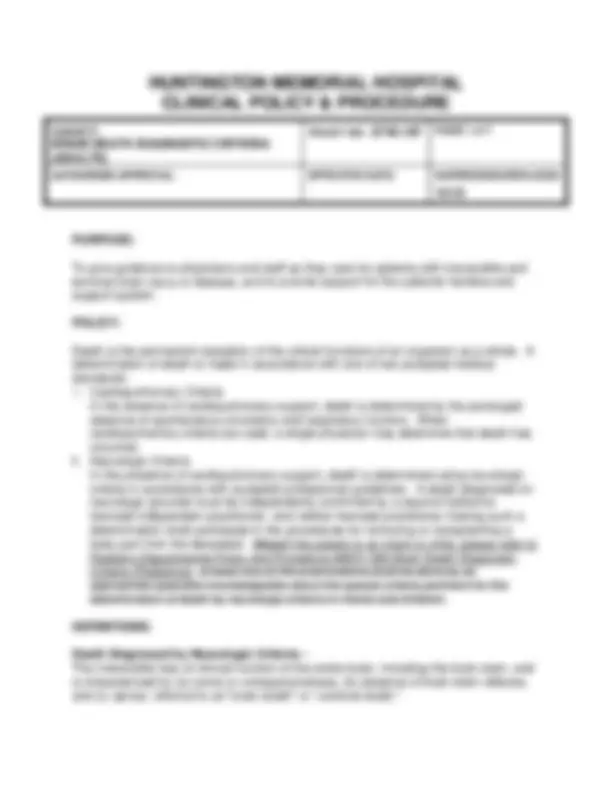
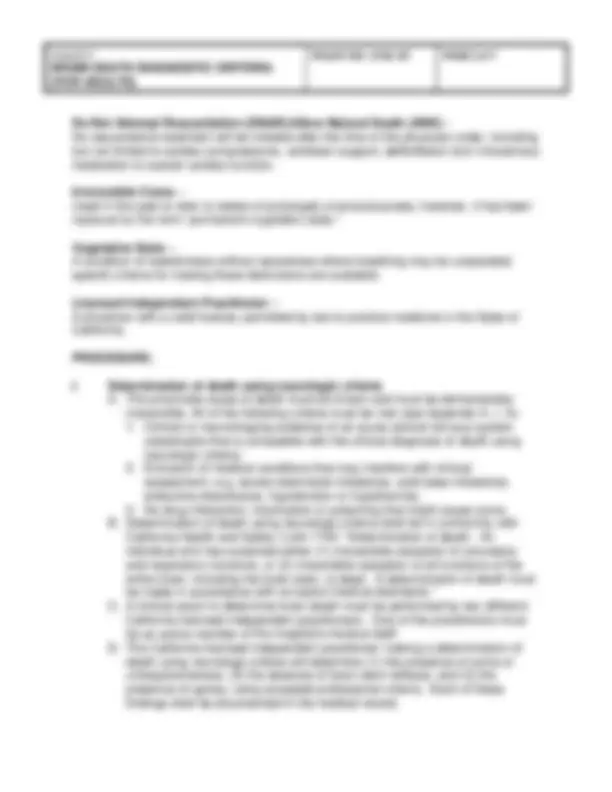
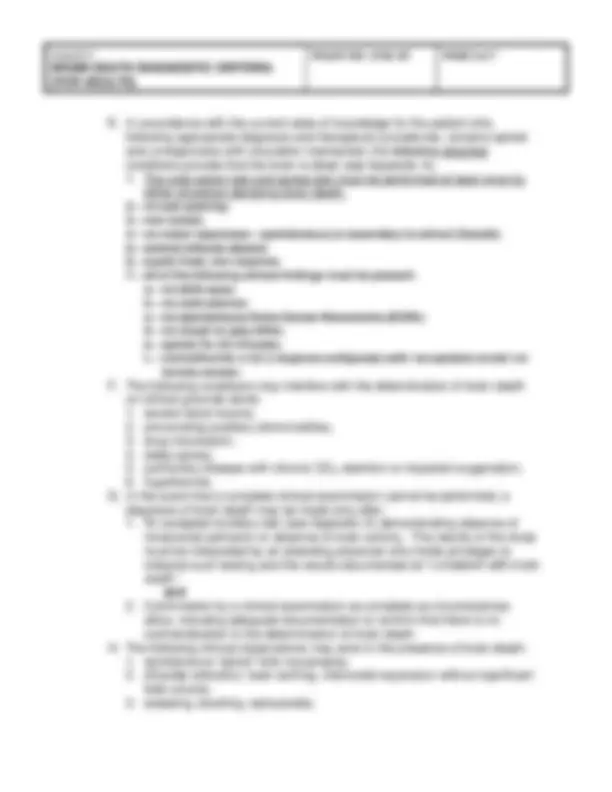
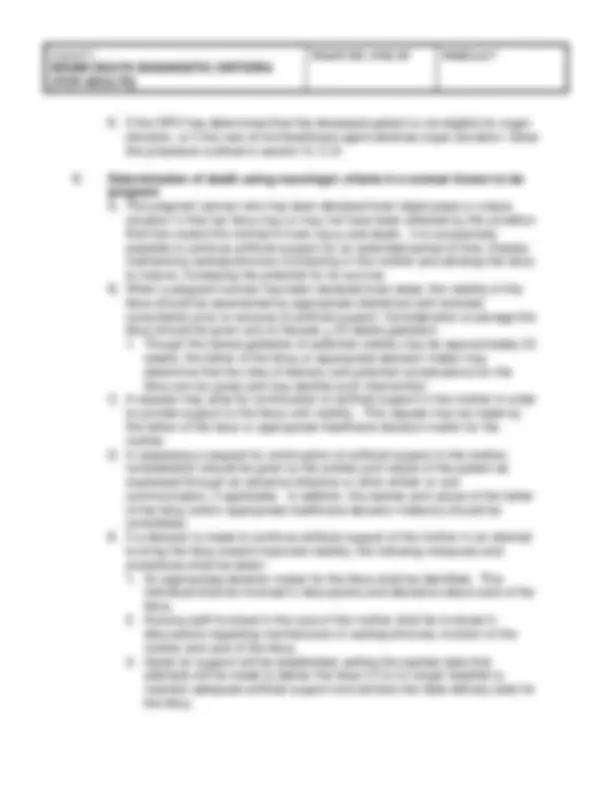
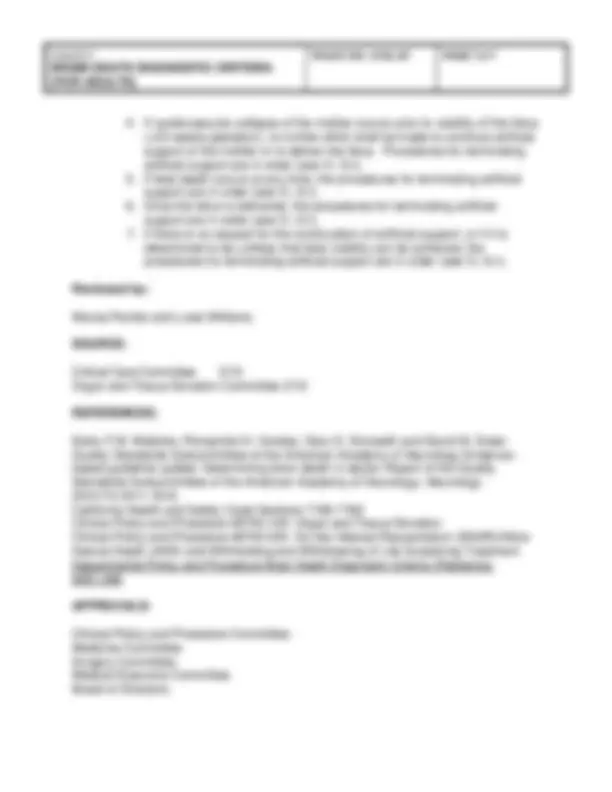
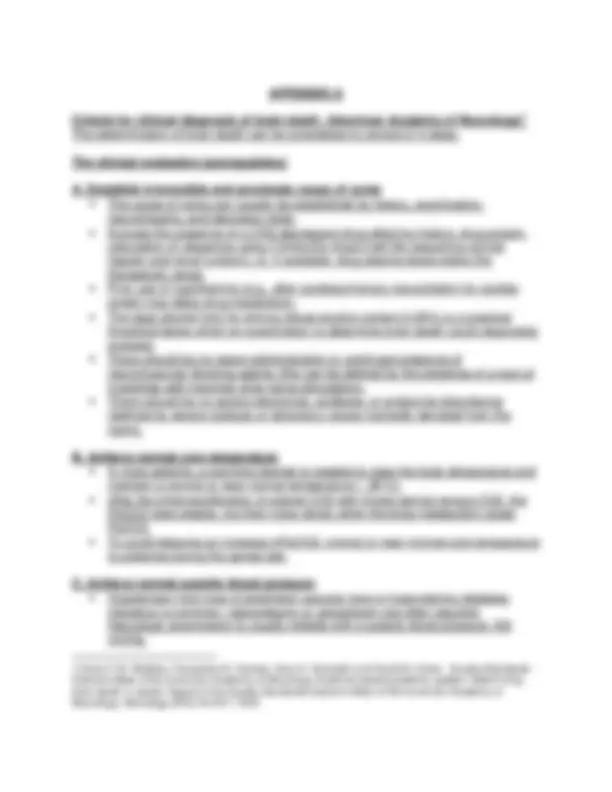
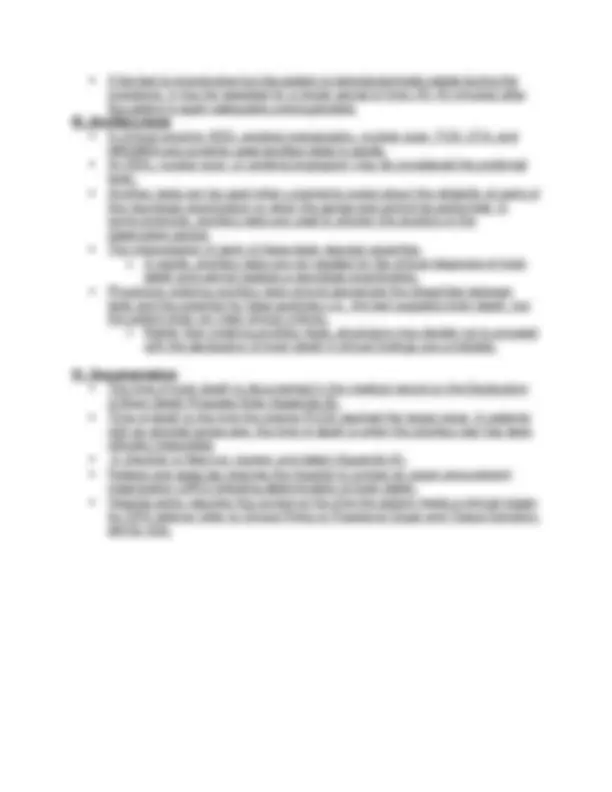
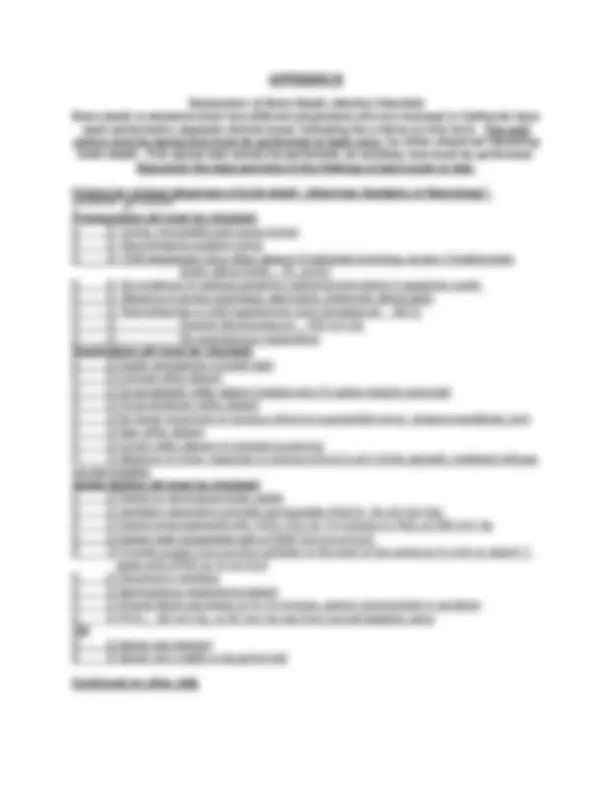
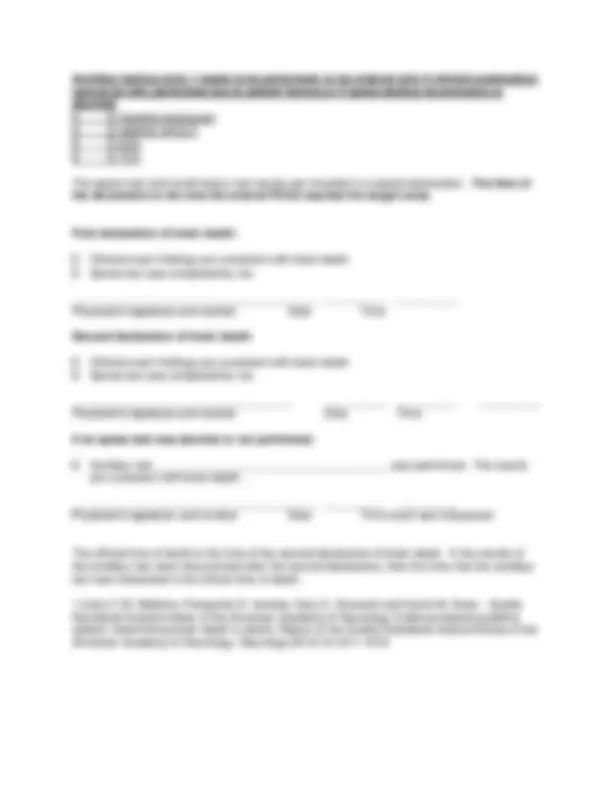


Study with the several resources on Docsity

Earn points by helping other students or get them with a premium plan


Prepare for your exams
Study with the several resources on Docsity

Earn points to download
Earn points by helping other students or get them with a premium plan
Community
Ask the community for help and clear up your study doubts
Discover the best universities in your country according to Docsity users
Free resources
Download our free guides on studying techniques, anxiety management strategies, and thesis advice from Docsity tutors
The criteria for clinically diagnosing brain death in adults according to the American Academy of Neurology. It outlines the prerequisites, clinical exam findings, and ancillary testing required for the determination of brain death. The document also includes quality standards and legal considerations.
Typology: Lecture notes
1 / 15

This page cannot be seen from the preview
Don't miss anything!










Declaration of Brain Death (Adults) Brain death is declared when two different physicians who are licensed in California have each performed a separate clinical exam, following the criteria on this form. The cold caloric and the apnea test must be performed at least once, by either physician declaring brain death. If an apnea test cannot be performed, an ancillary test must be performed. Document the date and time of the findings of each exam or test.
Criteria for clinical diagnosis of brain death (American Academy of Neurology)^1. 1 st physician^2 nd physician Prerequisites (all must be checked) Coma, irreversible and cause known Neuroimaging explains coma CNS depressant drug effect absent (if indicated toxicology screen; if barbiturates given, serum level _ 10 _g/mL) No evidence of residual paralytics (electrical stimulation if paralytics used). Absence of severe acid-base, electrolyte, endocrine abnormality Normothermia or mild hypothermia (core temperature _ 36°C) Systolic blood pressure _ 100 mm Hg No spontaneous respirations Examination (all must be checked) Pupils nonreactive to bright light Corneal reflex absent Oculocephalic reflex absent (tested only if C-spine integrity ensured) Oculovestibular reflex absent No facial movement to noxious stimuli at supraorbital nerve, temporomandibular joint Gag reflex absent Cough reflex absent to tracheal suctioning Absence of motor response to noxious stimuli in all 4 limbs (spinally mediated reflexes are permissible) Apnea testing (all must be checked) Patient is hemodynamically stable Ventilator adjusted to provide normocarbia (PaCo2 34–45 mm Hg) Patient preoxygenated with 100% FiO2 for _ 10 minutes to PaO2 _ 200 mm Hg Patient well-oxygenated with a PEEP of 5 cm of water Provide oxygen via a suction catheter to the level of the carina at 6 L/min or attach T-piece with CPAP at 10 cm H2O Disconnect ventilator Spontaneous respirations absent Arterial blood gas drawn at 8–10 minutes, patient reconnected to ventilator PCO2 _ 60 mm Hg, or 20 mm Hg rise from normal baseline value OR Apnea test aborted Apnea test unable to be performed Ancillary testing (only 1 needs to be performed; to be ordered only if clinical examination cannot be fully performed due to patient factors,or if apnea testing inconclusive or aborted) Cerebral angiogram HMPAO SPECT EEG TCD
The apnea test and confirmatory test results are included in a signed declaration. The time of the declaration is the time the arterial PCO2 reached the target value. First declaration of brain death:
Clinical exam findings are consistent with brain death. Apnea test was completed by me.
Physician’s signature and number Date Time
Second declaration of brain death:
Clinical exam findings are consistent with brain death. Apnea test was completed by me.
Physician’s signature and number Date Time
If an apnea test was aborted or not performed:
Ancillary test ______________________________________ was performed. The results are consistent with brain death.
Physician’s signature and number Date Time result was interpreted
The official time of death is the time of the second declaration of brain death. If the results of the ancillary test were documented after the second declaration, then the time that the ancillary test was interpreted is the official time of death.
1 Eelco F.M. Wijdicks, Panayiotis N. Varelas, Gary S. Gronseth and David M. Greer. Quality Standards Subcommittee of the American Academy of Neurology Evidence-based guideline update: Determining brain death in adults: Report of the Quality Standards Subcommittee of the American Academy of Neurology; Neurology 2010;74;1911-
SUBJECT: BRAIN DEATH DIAGNOSTIC CRITERIA (FOR ADULTS)
POLICY NO: 8740.197 PAGE 2 of 7
Do Not Attempt Resuscitation (DNAR)/Allow Natural Death (AND) - No resuscitative treatment will be initiated after the time of the physician order, including but not limited to cardiac compressions, ventilator support, defibrillation &/or intravenous medication to sustain cardiac function.
Irreversible Coma – Used in the past to refer to states of prolonged unconsciousness; however, it has been replaced by the term “permanent vegetative state.”
Vegetative State – A condition of wakefulness without awareness where breathing may be unassisted; specific criteria for making these distinctions are available.
Licensed Independent Practitioner – A physician with a valid license, permitted by law to practice medicine in the State of California.
PROCEDURE:
I. Determination of death using neurologic criteria A. The proximate cause of death must be known and must be demonstrably irreversible. All of the following criteria must be met (see Appendix A, I, A):
SUBJECT: BRAIN DEATH DIAGNOSTIC CRITERIA (FOR ADULTS)
POLICY NO: 8740.197 PAGE 3 of 7
E. In accordance with the current state of knowledge for the patient who, following appropriate diagnosis and therapeutic procedures, remains apneic and unresponsive with circulation maintained, the following attached conditions provide that the brain is dead (see Appendix A).
SUBJECT: BRAIN DEATH DIAGNOSTIC CRITERIA (FOR ADULTS)
POLICY NO: 8740.197 PAGE 5 of 7
IV. Organ Donation A. When a patient meets the clinical triggers for referral and/or when possible brain death is considered, the Organ Procurement Organization (OPO) must be notified to determine if the patient is eligible for organ donation. (Refer to Clinical Policy and Procedure #8740.109 Organ and Tissue Donation.) B. After both declarations of brain death have been made, artificial support will be continued until there is a determination by the OPO of the patient’s eligibility for and patient’s/family’s consent to organ donation. (Refer to Clinical Policy and Procedure #8740.109 Organ and Tissue Donation.) C. If the OPO has determined that the patient is eligible for organ donation, artificial support should be continued until a representative from the OPO has approached the next-of-kin/healthcare agent to offer organ donation. The decision of whether or not the next-of-kin/healthcare agent consents to organ and/or tissue donation should be obtained within four (4) hours of the OPO completing their approach. D. If there is no known next-of-kin/healthcare agent, refer to Clinical Policy and Procedure #8740.109 Organ and Tissue Donation, Attachment A, Diligent Search.
SUBJECT: BRAIN DEATH DIAGNOSTIC CRITERIA (FOR ADULTS)
POLICY NO: 8740.197 PAGE 6 of 7
E. If the OPO has determined that the deceased patient is not eligible for organ donation, or if the next-of-kin/healthcare agent declines organ donation, follow the procedure outlined in section III, C-D.
V. Determination of death using neurologic criteria in a woman known to be pregnant A. The pregnant woman who has been declared brain dead poses a unique situation in that her fetus may or may not have been affected by the condition that has caused the woman’s brain injury and death. It is occasionally possible to continue artificial support for an extended period of time, thereby maintaining cardiopulmonary functioning in the mother and allowing the fetus to mature, increasing the potential for its survival. B. When a pregnant woman has been declared brain dead, the viability of the fetus should be ascertained by appropriate obstetrical and neonatal consultation prior to removal of artificial support. Consideration to salvage the fetus should be given only to fetuses > 23 weeks gestation.
Criteria for clinical diagnosis of brain death (American Academy of Neurology)^1 The determination of brain death can be considered to consist of 4 steps.
The clinical evaluation (prerequisites)
A. Establish irreversible and proximate cause of coma The cause of coma can usually be established by history, examination, neuroimaging, and laboratory tests. Exclude the presence of a CNS-depressant drug effect by history, drug screen, calculation of clearance using 5 times the drug’s half-life (assuming normal hepatic and renal function), or, if available, drug plasma levels below the therapeutic range. Prior use of hypothermia (e.g., after cardiopulmonary resuscitation for cardiac arrest) may delay drug metabolism. The legal alcohol limit for driving (blood alcohol content 0.08%) is a practical threshold below which an examination to determine brain death could reasonably proceed. There should be no recent administration or continued presence of neuromuscular blocking agents (this can be defined by the presence of a train of 4 twitches with maximal ulnar nerve stimulation). There should be no severe electrolyte, acidbase, or endocrine disturbance (defined by severe acidosis or laboratory values markedly deviated from the norm).
B. Achieve normal core temperature In most patients, a warming blanket is needed to raise the body temperature and maintain a normal or near-normal temperature (_36°C). After the initial equilibration of arterial CO2 with mixed central venous CO2, the PaCO2 rises steeply, but then more slowly when the body metabolism raises PaCO2. To avoid delaying an increase inPaCO2, normal or near-normal core temperature is preferred during the apnea test.
C. Achieve normal systolic blood pressure Hypotension from loss of peripheral vascular tone or hypovolemia (diabetes insipidus) is common; vasopressors or vasopressin are often required. Neurologic examination is usually reliable with a systolic blood pressure 100 mmHg.
1 Eelco F.M. Wijdicks, Panayiotis N. Varelas, Gary S. Gronseth and David M. Greer. Quality Standards Subcommittee of the American Academy of Neurology Evidence-based guideline update: Determining brain death in adults: Report of the Quality Standards Subcommittee of the American Academy of Neurology; Neurology 2010;74;1911-
D. Perform 2 neurologic examinations California statute requires 2 examinations to determine brain death.
III. The clinical evaluation (neurologic assessment)
A. Coma
- Patients must lack all evidence of responsiveness. Eye opening or eye movement to noxious stimuli is absent. Noxious stimuli should not produce a motor response other than spinally mediated reflexes. The clinical differentiation of spinal responses from retained motor responses associated with brain activity requires expertise.
B. Absence of brainstem reflexes
If the test is inconclusive but the patient is hemodynamically stable during the procedure, it may be repeated for a longer period of time (10–15 minutes) after the patient is again adequately preoxygenated. III. Ancillary tests In clinical practice, EEG, cerebral angiography, nuclear scan, TCD, CTA, and MRI/MRA are currently used ancillary tests in adults. An EEG, nuclear scan, or cerebral angiogram may be considered the preferred tests. Ancillary tests can be used when uncertainty exists about the reliability of parts of the neurologic examination or when the apnea test cannot be performed. In some protocols, ancillary tests are used to shorten the duration of the observation period. The interpretation of each of these tests requires expertise. o In adults, ancillary tests are not needed for the clinical diagnosis of brain death and cannot replace a neurologic examination. Physicians ordering ancillary tests should appreciate the disparities between tests and the potential for false-positives (i.e., the test suggests brain death, but the patient does not meet clinical criteria). o Rather than ordering ancillary tests, physicians may decide not to proceed with the declaration of brain death if clinical findings are unreliable.
IV. Documentation The time of brain death is documented in the medical record on the Declaration of Brain Death Progress Note (Appendix B). Time of death is the time the arterial PCO2 reached the target value. In patients with an aborted apnea test, the time of death is when the ancillary test has been officially interpreted. A checklist is filled out, signed, and dated (Appendix B). Federal and state law requires the hospital to contact an organ procurement organization (OPO) following determination of brain death. Hospital policy requires this contact at the time the patient meets a clinical trigger for OPO referral (refer to Clinical Policy & Procedure Organ and Tissue Donation, #8740.109).
Declaration of Brain Death (Adults) Checklist Brain death is declared when two different physicians who are licensed in California have each performed a separate clinical exam, following the criteria on this form. The cold caloric and the apnea test must be performed at least once, by either physician declaring brain death. If an apnea test cannot be performed, an ancillary test must be performed. Document the date and time of the findings of each exam or test.
Criteria for clinical diagnosis of brain death (American Academy of Neurology)^1. 1 st physician^2 nd physician Prerequisites (all must be checked) Coma, irreversible and cause known Neuroimaging explains coma CNS depressant drug effect absent (if indicated toxicology screen; if barbiturates given, serum level _ 10 _g/mL) No evidence of residual paralytics (electrical stimulation if paralytics used). Absence of severe acid-base, electrolyte, endocrine abnormality Normothermia or mild hypothermia (core temperature _ 36°C) Systolic blood pressure _ 100 mm Hg No spontaneous respirations Examination (all must be checked) Pupils nonreactive to bright light Corneal reflex absent Oculocephalic reflex absent (tested only if C-spine integrity ensured) Oculovestibular reflex absent No facial movement to noxious stimuli at supraorbital nerve, temporomandibular joint Gag reflex absent Cough reflex absent to tracheal suctioning Absence of motor response to noxious stimuli in all 4 limbs (spinally mediated reflexes are permissible) Apnea testing (all must be checked) Patient is hemodynamically stable Ventilator adjusted to provide normocarbia (PaCO 2 34 – 45 mm Hg) Patient preoxygenated with 100% FiO 2 for 10 minutes to PaO 2 of 200 mm Hg Patient well-oxygenated with a PEEP of 5 cm of H 2 O Provide oxygen via a suction catheter to the level of the carina at 6 L/min or attach T- piece with CPAP at 10 cm H 2 O Disconnect ventilator Spontaneous respirations absent Arterial blood gas drawn at 8–10 minutes, patient reconnected to ventilator PCO 2 _ 60 mm Hg, or 20 mm Hg rise from normal baseline value OR Apnea test aborted Apnea test unable to be performed
Continued on other side